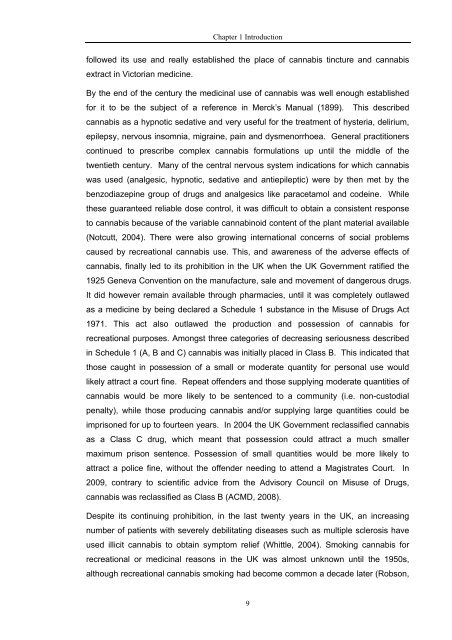finalfullthesisdjpotter
finalfullthesisdjpotter
finalfullthesisdjpotter
Create successful ePaper yourself
Turn your PDF publications into a flip-book with our unique Google optimized e-Paper software.
Chapter 1 Introduction<br />
followed its use and really established the place of cannabis tincture and cannabis<br />
extract in Victorian medicine.<br />
By the end of the century the medicinal use of cannabis was well enough established<br />
for it to be the subject of a reference in Merck’s Manual (1899). This described<br />
cannabis as a hypnotic sedative and very useful for the treatment of hysteria, delirium,<br />
epilepsy, nervous insomnia, migraine, pain and dysmenorrhoea. General practitioners<br />
continued to prescribe complex cannabis formulations up until the middle of the<br />
twentieth century. Many of the central nervous system indications for which cannabis<br />
was used (analgesic, hypnotic, sedative and antiepileptic) were by then met by the<br />
benzodiazepine group of drugs and analgesics like paracetamol and codeine. While<br />
these guaranteed reliable dose control, it was difficult to obtain a consistent response<br />
to cannabis because of the variable cannabinoid content of the plant material available<br />
(Notcutt, 2004). There were also growing international concerns of social problems<br />
caused by recreational cannabis use. This, and awareness of the adverse effects of<br />
cannabis, finally led to its prohibition in the UK when the UK Government ratified the<br />
1925 Geneva Convention on the manufacture, sale and movement of dangerous drugs.<br />
It did however remain available through pharmacies, until it was completely outlawed<br />
as a medicine by being declared a Schedule 1 substance in the Misuse of Drugs Act<br />
1971. This act also outlawed the production and possession of cannabis for<br />
recreational purposes. Amongst three categories of decreasing seriousness described<br />
in Schedule 1 (A, B and C) cannabis was initially placed in Class B. This indicated that<br />
those caught in possession of a small or moderate quantity for personal use would<br />
likely attract a court fine. Repeat offenders and those supplying moderate quantities of<br />
cannabis would be more likely to be sentenced to a community (i.e. non-custodial<br />
penalty), while those producing cannabis and/or supplying large quantities could be<br />
imprisoned for up to fourteen years. In 2004 the UK Government reclassified cannabis<br />
as a Class C drug, which meant that possession could attract a much smaller<br />
maximum prison sentence. Possession of small quantities would be more likely to<br />
attract a police fine, without the offender needing to attend a Magistrates Court. In<br />
2009, contrary to scientific advice from the Advisory Council on Misuse of Drugs,<br />
cannabis was reclassified as Class B (ACMD, 2008).<br />
Despite its continuing prohibition, in the last twenty years in the UK, an increasing<br />
number of patients with severely debilitating diseases such as multiple sclerosis have<br />
used illicit cannabis to obtain symptom relief (Whittle, 2004). Smoking cannabis for<br />
recreational or medicinal reasons in the UK was almost unknown until the 1950s,<br />
although recreational cannabis smoking had become common a decade later (Robson,<br />
9


